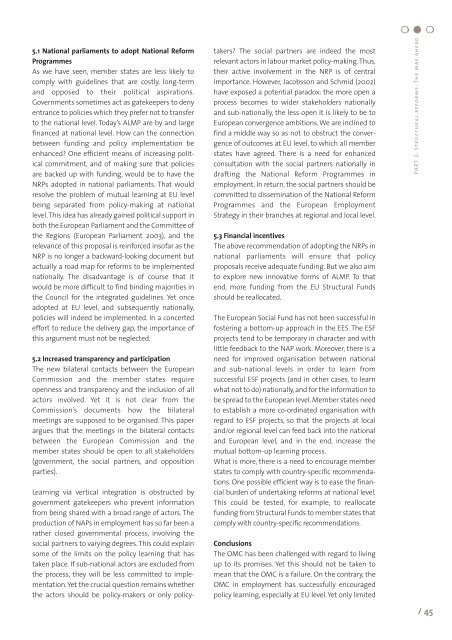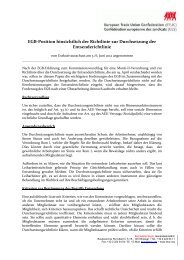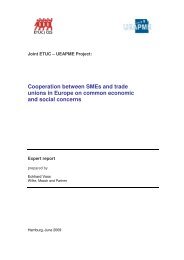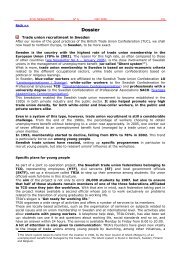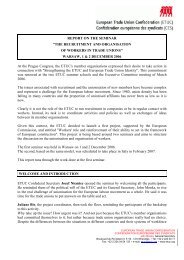Structural reforms and macro-economic policy - ETUC
Structural reforms and macro-economic policy - ETUC
Structural reforms and macro-economic policy - ETUC
Create successful ePaper yourself
Turn your PDF publications into a flip-book with our unique Google optimized e-Paper software.
5.1 National parliaments to adopt National Reform<br />
Programmes<br />
As we have seen, member states are less likely to<br />
comply with guidelines that are costly, long-term<br />
<strong>and</strong> opposed to their political aspirations.<br />
Governments sometimes act as gatekeepers to deny<br />
entrance to policies which they prefer not to transfer<br />
to the national level. Today’s ALMP are by <strong>and</strong> large<br />
financed at national level. How can the connection<br />
between funding <strong>and</strong> <strong>policy</strong> implementation be<br />
enhanced? One efficient means of increasing political<br />
commitment, <strong>and</strong> of making sure that policies<br />
are backed up with funding, would be to have the<br />
NRPs adopted in national parliaments. That would<br />
resolve the problem of mutual learning at EU level<br />
being separated from <strong>policy</strong>-making at national<br />
level.This idea has already gained political support in<br />
both the European Parliament <strong>and</strong> the Committee of<br />
the Regions (European Parliament 2003), <strong>and</strong> the<br />
relevance of this proposal is reinforced insofar as the<br />
NRP is no longer a backward-looking document but<br />
actually a road map for <strong>reforms</strong> to be implemented<br />
nationally. The disadvantage is of course that it<br />
would be more difficult to find binding majorities in<br />
the Council for the integrated guidelines. Yet once<br />
adopted at EU level, <strong>and</strong> subsequently nationally,<br />
policies will indeed be implemented. In a concerted<br />
effort to reduce the delivery gap, the importance of<br />
this argument must not be neglected.<br />
5.2 Increased transparency <strong>and</strong> participation<br />
The new bilateral contacts between the European<br />
Commission <strong>and</strong> the member states require<br />
openness <strong>and</strong> transparency <strong>and</strong> the inclusion of all<br />
actors involved. Yet it is not clear from the<br />
Commission’s documents how the bilateral<br />
meetings are supposed to be organised. This paper<br />
argues that the meetings in the bilateral contacts<br />
between the European Commission <strong>and</strong> the<br />
member states should be open to all stakeholders<br />
(government, the social partners, <strong>and</strong> opposition<br />
parties).<br />
Learning via vertical integration is obstructed by<br />
government gatekeepers who prevent information<br />
from being shared with a broad range of actors. The<br />
production of NAPs in employment has so far been a<br />
rather closed governmental process, involving the<br />
social partners to varying degrees. This could explain<br />
some of the limits on the <strong>policy</strong> learning that has<br />
taken place. If sub-national actors are excluded from<br />
the process, they will be less committed to implementation.<br />
Yet the crucial question remains whether<br />
the actors should be <strong>policy</strong>-makers or only <strong>policy</strong>-<br />
takers? The social partners are indeed the most<br />
relevant actors in labour market <strong>policy</strong>-making.Thus,<br />
their active involvement in the NRP is of central<br />
importance. However, Jacobsson <strong>and</strong> Schmid (2002)<br />
have exposed a potential paradox: the more open a<br />
process becomes to wider stakeholders nationally<br />
<strong>and</strong> sub-nationally, the less open it is likely to be to<br />
European convergence ambitions. We are inclined to<br />
find a middle way so as not to obstruct the convergence<br />
of outcomes at EU level, to which all member<br />
states have agreed. There is a need for enhanced<br />
consultation with the social partners nationally in<br />
drafting the National Reform Programmes in<br />
employment. In return, the social partners should be<br />
committed to dissemination of the National Reform<br />
Programmes <strong>and</strong> the European Employment<br />
Strategy in their branches at regional <strong>and</strong> local level.<br />
5.3 Financial incentives<br />
The above recommendation of adopting the NRPs in<br />
national parliaments will ensure that <strong>policy</strong><br />
proposals receive adequate funding. But we also aim<br />
to explore new innovative forms of ALMP. To that<br />
end, more funding from the EU <strong>Structural</strong> Funds<br />
should be reallocated.<br />
The European Social Fund has not been successful in<br />
fostering a bottom-up approach in the EES. The ESF<br />
projects tend to be temporary in character <strong>and</strong> with<br />
little feedback to the NAP work. Moreover, there is a<br />
need for improved organisation between national<br />
<strong>and</strong> sub-national levels in order to learn from<br />
successful ESF projects (<strong>and</strong> in other cases, to learn<br />
what not to do) nationally, <strong>and</strong> for the information to<br />
be spread to the European level. Member states need<br />
to establish a more co-ordinated organisation with<br />
regard to ESF projects, so that the projects at local<br />
<strong>and</strong>/or regional level can feed back into the national<br />
<strong>and</strong> European level, <strong>and</strong> in the end, increase the<br />
mutual bottom-up learning process.<br />
What is more, there is a need to encourage member<br />
states to comply with country-specific recommendations.<br />
One possible efficient way is to ease the financial<br />
burden of undertaking <strong>reforms</strong> at national level.<br />
This could be tested, for example, to reallocate<br />
funding from <strong>Structural</strong> Funds to member states that<br />
comply with country-specific recommendations.<br />
Conclusions<br />
The OMC has been challenged with regard to living<br />
up to its promises. Yet this should not be taken to<br />
mean that the OMC is a failure. On the contrary, the<br />
OMC in employment has successfully encouraged<br />
<strong>policy</strong> learning, especially at EU level. Yet only limited<br />
PART 2: <strong>Structural</strong> <strong>reforms</strong>: The way ahead<br />
/ 45


